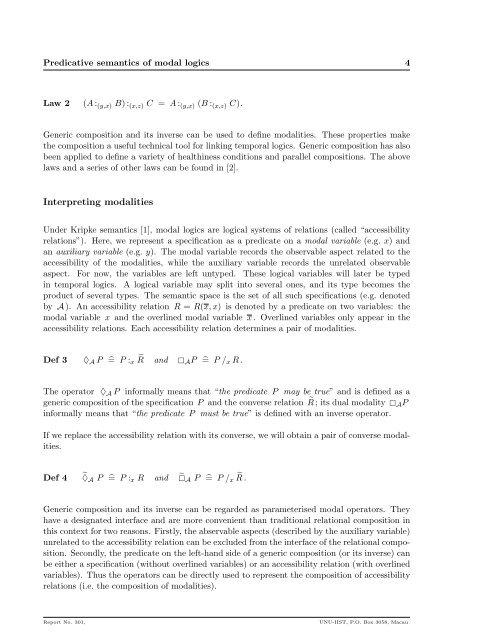IIST and UNU - UNU-IIST - United Nations University
IIST and UNU - UNU-IIST - United Nations University
IIST and UNU - UNU-IIST - United Nations University
You also want an ePaper? Increase the reach of your titles
YUMPU automatically turns print PDFs into web optimized ePapers that Google loves.
Predicative semantics of modal logics 4<br />
Law 2<br />
(A : (y,x) B) : (x,z) C = A : (y,x) (B : (x,z) C).<br />
Generic composition <strong>and</strong> its inverse can be used to define modalities. These properties make<br />
the composition a useful technical tool for linking temporal logics. Generic composition has also<br />
been applied to define a variety of healthiness conditions <strong>and</strong> parallel compositions. The above<br />
laws <strong>and</strong> a series of other laws can be found in [2].<br />
Interpreting modalities<br />
Under Kripke semantics [1], modal logics are logical systems of relations (called “accessibility<br />
relations”). Here, we represent a specification as a predicate on a modal variable (e.g. x) <strong>and</strong><br />
an auxiliary variable (e.g. y). The modal variable records the observable aspect related to the<br />
accessibility of the modalities, while the auxiliary variable records the unrelated observable<br />
aspect. For now, the variables are left untyped. These logical variables will later be typed<br />
in temporal logics. A logical variable may split into several ones, <strong>and</strong> its type becomes the<br />
product of several types. The semantic space is the set of all such specifications (e.g. denoted<br />
by A ). An accessibility relation R = R(x, x) is denoted by a predicate on two variables: the<br />
modal variable x <strong>and</strong> the overlined modal variable x . Overlined variables only appear in the<br />
accessibility relations. Each accessibility relation determines a pair of modalities.<br />
Def 3 ♦ A P ̂= P : x ˜R <strong>and</strong> A P ̂= P / x R .<br />
The operator ♦ A P informally means that “the predicate P may be true” <strong>and</strong> is defined as a<br />
generic composition of the specification P <strong>and</strong> the converse relation ˜R ; its dual modality A P<br />
informally means that “the predicate P must be true” is defined with an inverse operator.<br />
If we replace the accessibility relation with its converse, we will obtain a pair of converse modalities.<br />
Def 4 ˜♦A P ̂= P : x R <strong>and</strong> ˜ A P ̂= P / x ˜R .<br />
Generic composition <strong>and</strong> its inverse can be regarded as parameterised modal operators. They<br />
have a designated interface <strong>and</strong> are more convenient than traditional relational composition in<br />
this context for two reasons. Firstly, the abservable aspects (described by the auxiliary variable)<br />
unrelated to the accessibility relation can be excluded from the interface of the relational composition.<br />
Secondly, the predicate on the left-h<strong>and</strong> side of a generic composition (or its inverse) can<br />
be either a specification (without overlined variables) or an accessibility relation (with overlined<br />
variables). Thus the operators can be directly used to represent the composition of accessibility<br />
relations (i.e. the composition of modalities).<br />
Report No. 301,<br />
<strong>UNU</strong>-<strong>IIST</strong>, P.O. Box 3058, Macau
















